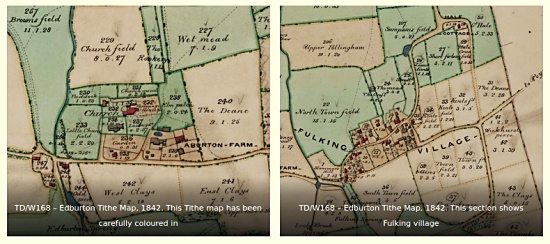This website frequently makes use of clips from the Edburton Tithe Map of 1842 to illustrate posts. Not a lot has changed hereabouts in the last 180 years so the map is still both useful and attractive. If you have ever wondered how such a map came to be, then the West Sussex County Record Office has an interesting recent post by Abigail Hartley, their Searchroom Archivist. She uses Edburton as an example of a tithe map that is still in superb condition. The map shows the ecclesiastical parish of Edburton, the area served by St. Andrew’s, and thus shows all of Fulking, together with Edburton proper.
The map is still available from the Record Office (details via the link above). Local walkers are probably best advised to order the JPEG version and copy it to a tablet or mobile phone for consultation in situ. Unlike a large scale OS map, the tithe map does not mark the status of routes as ‘bridleways’, ‘public footpaths’, etc. If you are relatively new to the area, and plan to use the map for walking, then you may want to use an image editor like Photoshop to copy those indications over from OS Explorer 122.
A tithe map, like the Domesday Book, is ultimately about taxation. To that end the Edburton map uses colour to distinguish between the buildings then used for human habitation (red) and all the others (grey), typically agricultural buildings for animal accommodation or feed storage. That distinction alone tells us quite a lot about mid-C19 activity in the central section of The Street (between the pub and the building now known as Yew Tree Cottage).
Another feature of the tithe map, not shared with any of the various iterations of OS maps, is that it records the names of (all!) the fields. These names are often full of information, thus ‘Fulking Mills’ is located just where two of the local spring streams merge, an ideal location for fulling mills; ‘Coneybeare’ and ‘Upper Coney Burrow’ were probably both once sources of rabbit meat, the latter conveniently placed for the Perching Manor dinner table; ‘The Rookery’ and ‘Hog Pasture’ need no translation; and nor does ‘Boggy Lagg’ if you make the mistake of traversing it in mid-February with the wrong shoes on.

